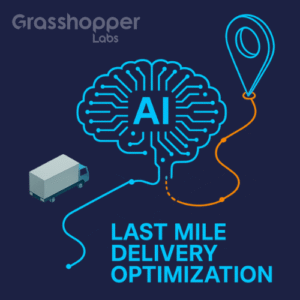Route Optimization Software
vs. Traditional Route Planning
Dynamic route optimization software isn’t just a smarter way to plan routes—it’s a fundamental shift in how transportation operations are managed.
Summary:
- Outdated routing software is a liability as your business grows.
- Dynamic route optimization software adapts in real-time.
- Upgrading your TMS unlocks smarter, scalable routing.
What Is Traditional Route Optimization?
But when unexpected changes hit—like traffic delays, driver callouts, or failed deliveries—an outdated transportation management system (TMS) can’t make adjustments on their own or alert drivers of changes in real-time.
Instead, they rely on manual input, forcing dispatchers and drivers to make reactive decisions—slowing down the entire operation.
Key characteristics of traditional route planning:
- Static routes based on fixed inputs
- No re-optimization without manual input
- High dependency on dispatchers or planners
- Little flexibility in adapting to same-day changes
What Is Dynamic Route Optimization Software?
Grasshopper’s dynamic route optimization software uses AI and machine learning to create and update routes in real time—combining historical delivery data with up-to-the-minute conditions to maximize delivery speed, fleet efficiency, and customer satisfaction while eliminating the manual guesswork that slows teams down.
Key characteristics of dynamic route optimization software:
- AI-powered routing that updates in real time
- Automated re-optimization based on live conditions
- Reduces dispatcher workload with smart decision-making
- Adapts instantly to same-day changes and disruptions
Why the Shift Matters
Grasshopper’s route optimization software helps:
- Lower fuel costs by reducing miles driven
- Improve customer satisfaction with accurate ETAs
- Prevent missed deliveries or service windows
- Real-time visibility gives dispatchers total control
Switching to dynamic route optimization software isn’t just an upgrade—it’s a necessary shift to stay competitive, efficient, and in control.
Side-by-Side Comparison
Feature | Traditional Route Planning | Dynamic Route Planning |
| Route Generation | Manual & Static | Automated / Real-Time |
| Re-Optimize Routes | Manual & Slow | Instant & Automatic |
| Traffic Updates | None | Live Traffic Included |
| ETA Windows | Fixed | Continuously Adjusted |
| Driver Availability | Must be Manually Considered | Automatically Factored In |
| Scalability | Limited | Designed for High-volume Delivery |
| Data Sources | Historical Only | Historical, Real-time & Predictive |
| Optimization Goals | Basic Mileage Reduction | Multi-factor Efficiency (Fuel, Time, etc.) |
Use Case: Last Mile Delivery

In last mile logistics, the final stretch of the delivery process is where delays and customer dissatisfaction are most common. Legacy TMS systems fall short here because they can’t react quickly to failed delivery attempts, traffic slowdowns, or added stops.
With dynamic route planning capabilities, your TMS software can instantly adjust routes, optimize for real-time driver location, and automatically notify customers of updated ETAs. This kind of adaptability helps reduce failed delivery attempts and ensures tighter control over the customer experience.
Dynamic Routing Starts with the Right TMS System
Not every TMS system is built for dynamic routing. Many legacy platforms are outdated, require third-party integrations, and only offer static route planning tools that can’t adapt to real-time changes.
Grasshopper was built differently. Our dynamic routing capabilities are powered by AI and fully integrated into our TMS. That means your routing engine is always connected to real-time delivery data, driver status, order changes, and customer availability.
With Grasshopper, you can:
- Generate and adjust routes automatically using real-time data
- Instantly reassign stops when orders are delayed or canceled
- Send live ETAs and updates directly to customers and drivers
- Manage routing, dispatch, billing, and order tracking in one place
If you’re currently optimizing routes on a TMS that can’t adapt in real time, it’s holding your business back. Grasshopper gives you dynamic routing—and the full-stack logistics software you need to move faster, reduce costs, and exceed customer expectations.
Cost Savings from Smarter Routing
One of the biggest advantages of AI-powered dynamic routing is its impact on your bottom line. Fuel, labor, and delivery delays add up fast when routes are planned manually or inefficiently.
Here’s how dynamic routing helps you cut costs:
- Fuel Reduction: Fewer miles and idle time due to optimized sequencing
- Labor Efficiency: Drivers complete more stops per hour
- Fewer Errors: AI considers complex constraints you might miss
- Lower Planning Overhead: Less manual input from dispatchers
Signs You’ve Outgrown Your Routing Software
Not sure if it’s time to make the switch? Here are some indicators:
- Your routes are built or adjusted manually
- You miss delivery windows or have frequent re-deliveries
- You’re expanding into new territories or adding more orders
- You lack visibility into driver performance and on-time rates
If these sound familiar, it may be time to upgrade to a smarter, more scalable solution.
Final Thoughts: Make Every Route Smarter
The logistics world doesn’t wait. And neither should your routing software.
Grasshopper’s dynamic routing software gives you the tools to respond faster, plan smarter, and keep your deliveries on track—no matter what the day throws your way.
It’s time to move past outdated systems that leave your team scrambling. With Grasshopper’s AI-powered TMS platform, you get dynamic routing built into your transportation workflow—along with dispatch automation, driver visibility, and delivery tracking.
Ready to optimize your transportation operations?
See Grasshopper Labs in action! >>> Book a demo



